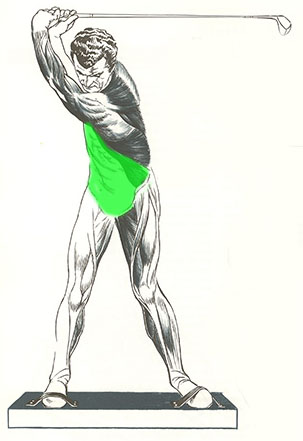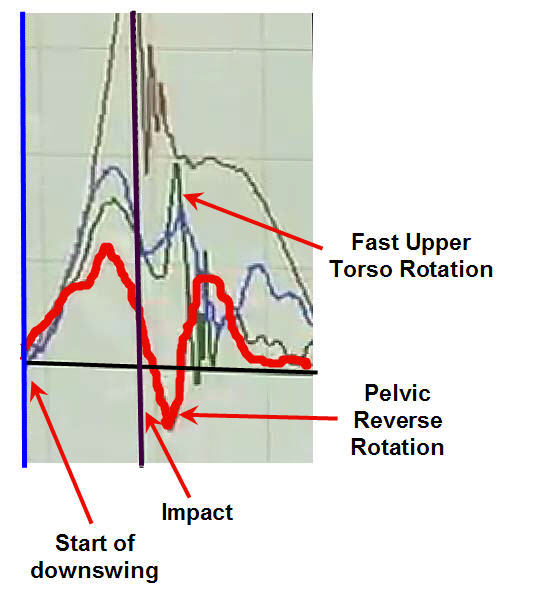|
|
Post by dubiousgolfer on May 19, 2020 20:26:44 GMT -5
Dr Mann Just been reading your critical review (written in 2008) and wondering whether it is still accurately representative of your current theories? DG PS. The diagrams below are my point of interest because it suggests that the pelvic pivot rotation in the downswing , stretches the abdominal muscles on the right side. So if that is the case , is the TGM swinging action (where the pivot pulls on the left shoulder socket) actually caused by the contraction of abdominal muscles on the right side? I am saying this because I am assuming the top diagram relates to the shoulder girdle muscles that are responsible for moving the left arm and not for rotating the upper torso.   If the pelvis rotates before the upper torso during the transition phase of the golf swing, then the abdominal wall muscles (depicted in green) are stretched, and they can therefore potentially contract a greater amount/distance per unit time when those abdominal wall muscles eventually become active during the early downswing. In other words, the increased active muscle power of those stretched abdominal wall muscles could potentially increase the uncoiling of the upper torso and generate faster upper torso rotational speeds. |
|
|
|
Post by imperfectgolfer on May 20, 2020 9:54:20 GMT -5
DG,
I think that the dynamic X-factor phenomenon, where the pelvis rotates counterclockwise first before the upper torso rotates, mainly stretches the external abdominal musculature, which will then cause the upper torso to potentially rotate counterclockwise with more force.
The stretching of the left shoulder girdle muscles is another (different) phenomenon that plays a far less important role in the release of PA#4.
Jeff.
|
|
|
|
Post by dubiousgolfer on May 20, 2020 20:37:38 GMT -5
Dr Mann
But doesn't this mean that to utilise the external/internal obliques (as per the 2nd diagram ) and rotate the torso there must be some stabilisation of the left leg?
So am I correct in assuming for a TGM swinging action, where a pivot releases PA#4 and the golfer uses your optimal method to rotate the pelvis, the left leg must be stabilised quite quickly during the pelvic squaring phase?
Is my logic below flawed?
First I checked which muscles could be used to rotate the torso looking at this video below (the 'Spiral Line' movement from 0:42- 0:47)
If the optimal kinematic sequence 'Pelvis/Thorax/Arm/Club' is applied for a TGM swinging action we should have:
1. Pelvic rotation as per your optimal method - ‘right leg/hip socket’ stabilised and then pelvic girdle rotary muscles activated to rotate the pelvis square (ie. the pelvis squaring stage).
2. Thorax rotation - left leg pressure loaded enough to stabilise, then 'right external oblique & left internal oblique' contracted to rotate the torso and release PA#4
3. Right/left shoulder girdle contractions to assist the release of PA#4 but point 2 above being the dominant power enabler.
If the above is correct, then :
4.The 'Thorax' cannot rotate or release PA#4 until there is enough pressure load on the left leg to enable contraction of the external/internal obliques.
If the above is true, will a golfer require a significant 'spinal slack' to achieve a TGM swinging action? The left arm cannot be moving in the downswing until the pelvis has started to square and enough pressure load on left leg has occurred.
DG
|
|
|
|
Post by imperfectgolfer on May 20, 2020 22:48:17 GMT -5
I don't understand why you believe that the left leg has to be stabilised for the external abdominal muscles to rotate the upper torso. Those muscles run between the rib cage and the pelvis, and those muscles can contract and shorten while the pelvis is undergoing its counterclockwise pelvic rotation. That will cause a counterclockwise rotation of the upper torso with a variable degree of torso-pelvic separation depending on the timing of their contraction.
Jeff.
|
|
|
|
Post by dubiousgolfer on May 21, 2020 8:32:21 GMT -5
I don't understand why you believe that the left leg has to be stabilised for the external abdominal muscles to rotate the upper torso. Those muscles run between the rib cage and the pelvis, and those muscles can contract and shorten while the pelvis is undergoing its counterclockwise pelvic rotation. That will cause a counterclockwise rotation of the upper torso with a variable degree of torso-pelvic separation depending on the timing of their contraction. Jeff. Dr Mann So you are asserting that the angular momentum of the pelvis being rotated (by the pelvic rotary muscles) is enough to allow the contraction of abdominal muscles and turn the torso? Basically that the pelvis angular momentum is enough to prevent those 'ab' muscles pulling the left side of pelvis clockwise (from a birds eye view for a right hander), even with the left leg significantly unweighted? DG |
|
|
|
Post by imperfectgolfer on May 21, 2020 9:12:59 GMT -5
I don't understand why you believe that the left leg has to be stabilised for the external abdominal muscles to rotate the upper torso. Those muscles run between the rib cage and the pelvis, and those muscles can contract and shorten while the pelvis is undergoing its counterclockwise pelvic rotation. That will cause a counterclockwise rotation of the upper torso with a variable degree of torso-pelvic separation depending on the timing of their contraction. Jeff. Dr Mann So you are asserting that the angular momentum of the pelvis being rotated (by the pelvic rotary muscles) is enough to allow the contraction of abdominal muscles and turn the torso? Basically that the pelvis angular momentum is enough to prevent those 'ab' muscles pulling the left side of pelvis clockwise (from a birds eye view for a right hander), even with the left leg significantly unweighted? DG How else can one explain the fact that most pro golfers rotate the pelvis and upper torso counterclockwise at nearly the same time and well before the left leg becomes fully stabilised? Here is Rory McIlroy's 3-D graph.  Note that his upper torso's angular velocity graph is above the zero line from the very start of the downswing and that there is only a very small amount of torso-pelvic separation between P4 and P5. Note that the upper torso's angular velocity graph is even steeper than the pelvis' angular velocity graph in the early downswing and it soon travels faster than the pelvis. Jeff. |
|
|
|
Post by dubiousgolfer on May 21, 2020 9:36:39 GMT -5
Many thanks Dr Mann - yes that makes sense, there doesn't seem to be any other way. DG PS. To check this out , I am trying to google for any force plate info on Rory but I did find this article below (comments by Mike Adams) golf.com/news/taylormade-3d-technology-reveals-the-secrets-to-rory-mcilroys-swing/He shifts first, turns second
Most golfers do three things in their swing: 1) They shift their weight forward and backward, 2) they move their weight up and down, and 3) they rotate. The key to unlocking maximum power is to ensure that these three actions occur in the right order. “When your sequence is off, your power is limited,” says GOLF Hall-of-Fame teacher Mike Adams. “You need to make sure that the peak forces are happening at the right time.” Once he reaches the top of his backswing, McIlroy shifts his weight toward the target. Then he rotates. This creates a chain reaction that pulls his upper body toward the ball, followed by his arms and then, finally, the club |
|
|
|
Post by dubiousgolfer on May 21, 2020 9:59:58 GMT -5
Actually you can see that he has turned his torso using his pelvic squaring stage and contraction of his abs in the video below (09:20 - 09:22). Mike Adams does not seem to be looking at the more detailed intricacies of the pelvic motion.
DG
|
|
|
|
Post by imperfectgolfer on May 21, 2020 19:17:25 GMT -5
It is obvious that Rory is rotating his upper torso a lot during his hip-squaring phase between P4 => P5. Look at these birds-eye view images.
Image 1 is at P4 and image 3 is at P5. Note that his upper torso was rotated about 120 degrees at P4 and it looks about 60-70 degrees closed at P5. That means that he has already rotated his upper torso counterclockwise by about 50+ degrees during his hip-squaring phase.
|
|
|
|
Post by dubiousgolfer on May 22, 2020 10:16:27 GMT -5
Dr Mann
Does the usefulness of an 'X-factor stretch' diminish if one doesn't have a high percentage of 'fast twitch' muscle fibers?
For example, if older golfers have less fast twitch muscle fibers and less pelvic/torso flexibility , would range of motion (ie. an arm based swing over a longer distance) be more appropriate?
Would there be any point in even trying to create X-factor stretch?
DG
|
|